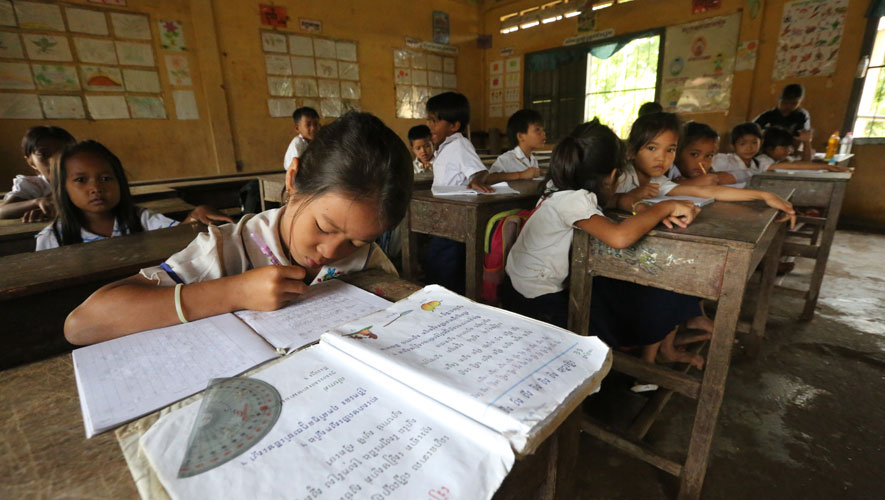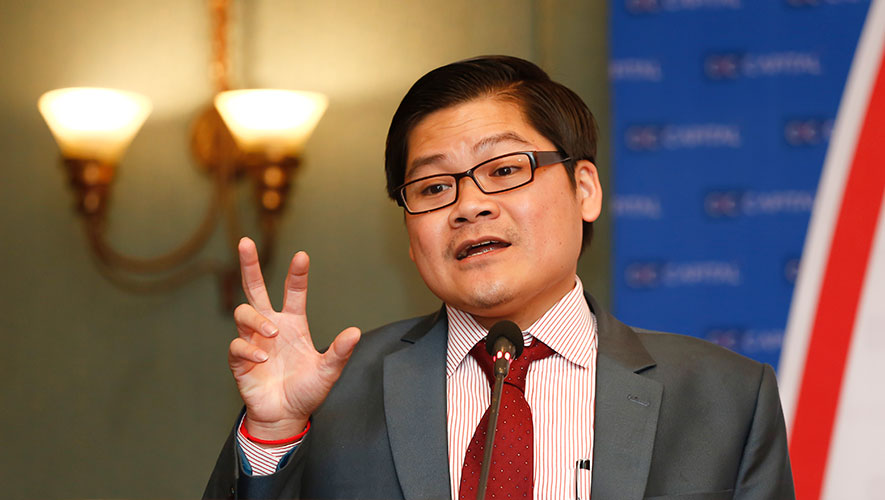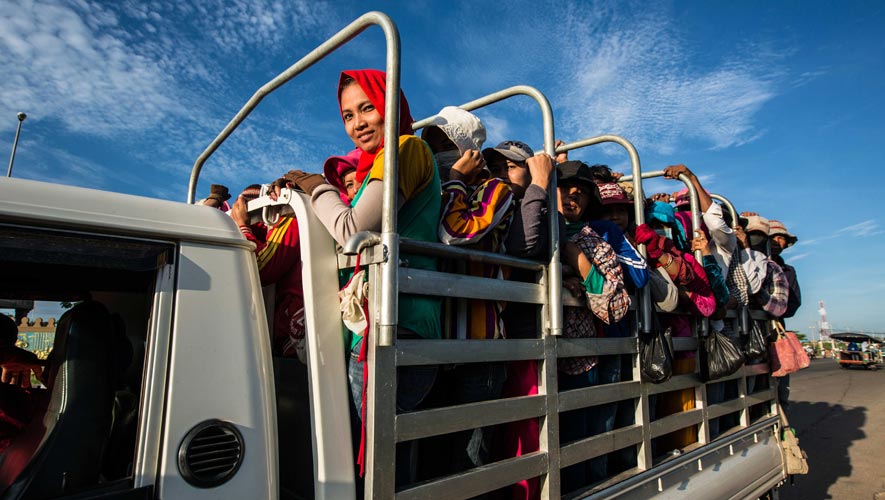Microsoft founder and billionaire philanthropist Bill Gates once noted: “The belief that the world is getting worse, that we can’t solve extreme poverty and disease, isn’t just mistaken. It is harmful.”
For the latest Cambodian Business news, visit Khmer Times Business
It’s a poignant statement backed up by Muhammad Yunus, Author of Banker to the Poor: Micro-Lending and the Battle against World Poverty. He said: “People… were poor not because they were stupid or lazy. They worked all day long, doing complex physical tasks. They were poor because the financial institutions in the country did not help them widen their economic base.”
Now, anyone who traverses at least some of Cambodia’s181,035 square kilometres and bumps into even a tiny section of the population of more than 15 million people cannot fail to have noticed the rich live cheek by jowl with those with very little to show for the endeavours.
So, surely, it’s an easy assumption to make that a better division of wealth can be made because problems are clear?
No. Not overnight. Many things need to be put into place before real poverty and Cambodia’s goal of reaching upper middle-income status by 2030 is reached,
The World Bank has noted over the past two decades, Cambodia has undergone a significant transition, reaching lower middle-income status in 2015.
One need only see the fancy cars gridlocking the streets, increased spending on fashion and imported food and a general air of optimism rather than a sad look of resignation among the people.
As the cliche goes, give a hungry man a fish and he’ll be sated for a while. Give him fishing tackle, bait and teach him to fish and he’ll be sated every day.
And in a less colourful way, that is exactly what the Cambodian government is seeking to achieve.
Driven by garment exports and tourism, Cambodia’s economy sustained an average growth rate of around 8 percent between 1998 and 2018, making it one of the fastest-growing economies in the world. While easing slightly, growth remains strong, according to a government report,projected to reach 7 percent in 2019, after the better-than-expected growth rate of 7.5 percent in 2018.
Compare that with the United Kingdom. Britain’s economy shrank 0.2 percent in the second quarter of 2019, compared with forecasts that had pointed to stagnation and following a 0.5 percent growth in the previous three-month period, a preliminary estimate showed. That was the first quarter of contraction since the last quarter of 2012.
Further research shows that poverty continues to fall in Cambodia. According to official estimates, the poverty rate in 2014 was 13.5 percent compared with 47.8 percent in 2007. About 90 percent of the poor live in the countryside.
But it’s not all about the money.
Health and education remain important challenges and development priorities for this government.
Cambodia has made considerable strides in improving maternal and child health, early childhood development, and primary education in rural areas.
The maternal mortality ratio per 100,000 live births decreased from 472 in 2005 to 170 in 2014; the under-5 mortality rate decreased from 83 per 1,000 live births in 2005 to 35 per 1,000 live births in 2014. Infant mortality rate decreased from 66 per 1,000 live births in 2005 to 28 per 1,000 live births in 2014.
I’m indebted to the government’s National Social Protection Policy Framework 2016 to 2015 for these figures.
It contains six chapters describing the situation and ways to improve it.
They include social protection, protection of pregnant women and children, a school feeding programme, pensions, health insurance, increasing investments in social infrastructure and human resources and a tax regime for social security schemes.
In its preamble, Prime Minister Hun Sen states: “The Royal Government of Cambodia’s primary goals are to maintain peace, political stability and national security.” Noble ambitions for a nation that endured genocide and devastation from 1975 to 1979, with peace only being fully restored in 1998.
Despite the progress in health and education outcomes, human capital indicators trail behind. A child born in Cambodia today will be only 49 percent as productive when fully grown up as she could be if she enjoyed full quality education, good health, and proper nutrition during childhood. Only 36 percent of 3 to 5 year-olds are enrolled in early education.
While net enrolment in primary education increased from 82 percent in 1997 to 97 percent in 2016, lower secondary completion rates, at 57 percent in 2017, are significantly below the average for lower middle-income countries.
Clearly, key reforms are needed for Cambodia to sustain growth out of poverty, foster competitiveness, sustainably manage natural resource wealth and improve access to, and quality of, public services. Cambodia continues to have a serious infrastructure problem and would benefit from greater connectivity and investments in rural and urban infrastructure are essential.
Further diversification of the economy will require fostering entrepreneurship, expanding the use of technology and building new skills to address emerging labour market needs.
There are other indications that life is improving. Indeed, Cambodian life expectancy was 72 years in 2014, a major improvement since 1995 when the average life expectancy was 55. Healthcare is offered by both public and private practitioners and research has found that trust in health providers is a key factor in improving the uptake of health care services in rural Cambodia.
Cambodia’s infant mortality rate decreased from 115 per 1,000 live births in 1993 to 54 in 2009. In the same period, the under-5 mortality rate decreased from 181 to 115 per 1,000 live births.
The constitution of Cambodia stipulates free compulsory education for nine years and guarantees the universal right to basic quality education. Consequently, literacy rates have risen dramatically. In my own experience, young Cambodians are better at English than many of their Thai counterparts.
Sreng Ang, a physics teacher who teaches grades 7 and 9 at Hun Sen Taing Kok High School, admires the new way of teaching and learning and observes that students learn faster, are more engaged in their study and find creative ways to present their discussions.
“When we assign a topic to be discussed, they find real tools to practise,” he said referring to his subject, physics.
Ieng Bunhan, Principal of Hun Sen Taing Kok High School, recalled that pre-tests of students who passed from primary to secondary school revealed that approximately 70 percent needed to strengthen their reading skills in order to be ready for grade 7.
The results of the pre-test for grade 9 were the same. He said that in first test for the month of December 2018, more than 65 percent – 82 out of 121 students – failed the exam. Only one student got a grade C and none earned A or B. Now, the pass rate has significantly improved. By the second semester, only less than 10 percent – 12 students – failed. Students receiving grades A, B, and C increased from 1 to 62 students.
“We have been asleep for a long time,” he said referring to the traditional ways of teaching and learning that were not effective.
Given these initial results, he wants all his teachers to attend the Teacher Upgrading Programme (TUP) at Royal University of Phnom Penh. So far, 12 out of 63 teachers in his high school have attended this training.
Although the project is still in its first year, it shows promising initial results.
The project has benefited more than 19,500 educational staff members, teachers and students. More than 17,000 students are enrolled in 350 newly constructed classrooms. One hundred targeted secondary schools have developed School Improvement Plans with support from national core trainers.
The first cohort of teacher trainees (almost 200 teachers) in the Teacher Upgrading Programme will graduate by the end of December 2019.
School construction has been mostly on track with active participation from communities.
The country has also significantly invested in vocational education, especially in rural areas, to tackle poverty and unemployment.
Earlier this year, the World Bank’s Board of Executive Directors endorsed the Country Partnership Framework (CPF) for Cambodia for 2019 to 2023.
The new CPF aims to focus on promoting state efficiency and boosting private sector development, fostering human development and improving agricultural productivity and the sustainable use of natural resources. Strengthening governance, institutions and public engagement will also be key.
These focus areas are aligned with national priorities as laid out in the current phase of the government’s Rectangular Strategy for Growth, Employment, Equity and Efficiency.
“Cambodia has sustained rapid growth and impressive poverty reduction over the past two decades, improving the living standards of most families,” said Inguna Dobraja, World Bank country manager for Cambodia.
“Cambodia faces three challenges: to shift toward a more diversified and higher-value economic base, to build human capital for a more sophisticated economy and to enhance economic inclusion to reach the remaining poor. The World Bank Group will partner with Cambodia to achieve these goals while strengthening citizens’ engagement in the development process.”
Under the first focus area of the CPF – promoting state efficiency and boosting private sector development – the World Bank Group will work with Cambodia to support financial sector development and foster private enterprise, strengthen public sector accountability and public financial management and expand needed investments in sustainable infrastructure.
“IFC [International Finance Corporation, part of the World Bank], with its focus on private sector development, will continue mobilising private financing and collaborating across the World Bank Group to promote a robust private sector in Cambodia,” said Kyle Kelhofer, IFC country manager for Cambodia, Laos and Vietnam.
“Our focuses will be expanding access to finance for smaller businesses, enhancing the country’s agricultural competitiveness and improving infrastructure services essential to business development.”
The CPF says as part of fostering human development, it aims to enhance the quality of education and continue alignment with labour demands, while expanding access to quality early childhood services, healthcare and nutrition services.
It says under agricultural productivity and strengthening the sustainable use of natural resources, the CPF will help improve the management of water and land resources and agricultural productivity and diversification.The CPF wants to strengthen governance, institutions and citizen engagement, which will be integrated in all World Bank-financed activities. “In this way, the World Bank will help give citizens a greater voice in the development process and encourage transparency and accountability at all levels of government,” it says.
To inform the development of the CPF, the World Bank Group conducted consultations with the National Assembly, government officials at both national and sub-national levels, private sector representatives, development partners and civil society organisations.
Regular readers of this newspaper will have noticed a huge drive by microfinance institutions and traditional banks to involve rural people in the financial sector – that is getting them “banked”.
From the above it can only be deduced that Cambodia is on the rise, shaking off the shackles of a dreadful and not so recent past. So, barring unpredictable events, its goal of becoming an upper middle class nation by 2030 seems viable.




